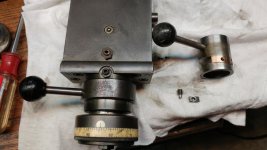It seems like the only way to get a Hardinge HLV is to create an alternate universe where I already have a HLV 
Meanwhile, I see TFB-s are going for much lower prices. If I get it right - it's basically the same lathe minus threading capabilities (i.e. threading lead screw and a gearbox).
I see some people do electronic lead screw mod to their lathes. I wonder if it's a viable option to buy a TFB and add an electronic lead screw to it. I'm an electrical/firmware engineer, so electronic part of it should be straightforward. Mechanical part is challenging though. I see a TFB has a smooth rod in place of a lead screw. What is that for? Can it be easily retrofitted with, say, ball screw?
Thanks!

Meanwhile, I see TFB-s are going for much lower prices. If I get it right - it's basically the same lathe minus threading capabilities (i.e. threading lead screw and a gearbox).
I see some people do electronic lead screw mod to their lathes. I wonder if it's a viable option to buy a TFB and add an electronic lead screw to it. I'm an electrical/firmware engineer, so electronic part of it should be straightforward. Mechanical part is challenging though. I see a TFB has a smooth rod in place of a lead screw. What is that for? Can it be easily retrofitted with, say, ball screw?
Thanks!




